
Miro
was an extremely versatile, inventive and prolific artist. His career does not
show any steady evolution of style, but rather an unquenchable thirst for
experiment, a tireless ability to absorb and transform new influences, and an
imaginative response to the varied qualities of the differing materials with
which he worked. Miro himself commented on the element of uncertainty and lack
of premeditation in his creative processes, writing 'It is difficult for me to
speak of my painting, for it is always born in a state of hallucination,
provoked by some shock or other, objective or subjective, for which I am
entirely unresponsible', and although he later modified the views in this
statement (made in 1933) it gives an indication of the fascinating unpredictability
of his work. It ranges from the loving detail of Kitchen Garden with a Donkey
to the daringly empty abstract forms of Blue III, from the mischievous
playfulness of Harlequin's Carnival to the bitter anger of Aidez l'Espagne. And
Mire's genius was such that he was just as happy working on a fairly small
scale in the medium of lithography as he was creating huge decorative murals.
Both satisfied his urge to create an art which belonged to the public at large,
by-passing the exclusivity of the museums.
 This
is one of the first paintings in which Mini worked in the style to which a
friend gave the name 'detallista', characterized by great attention to detail
and sharpness of focus from foreground to background. The overall feeling,
however, is not naturalistic, for the stylized forms and the rhythmic patterns
made by, for example, the lines of cultivation and the branches against the
sky, produce an effect somewhat like a complex stage set. Miro holds together
the diverse elements with consummate skill, and the bright colours and clear
forms convey with great vividness the heat of his native Catalonia.
This
is one of the first paintings in which Mini worked in the style to which a
friend gave the name 'detallista', characterized by great attention to detail
and sharpness of focus from foreground to background. The overall feeling,
however, is not naturalistic, for the stylized forms and the rhythmic patterns
made by, for example, the lines of cultivation and the branches against the
sky, produce an effect somewhat like a complex stage set. Miro holds together
the diverse elements with consummate skill, and the bright colours and clear
forms convey with great vividness the heat of his native Catalonia.
In
1938, Miro wrote an article in which he described the geitesis of this
painting, one of his most famous works and one of the first in which he
revealed his unmistakable personal style. At the time, he was experiencing a
period of great hardship and he wrote 'For Harlequin's Carnival I made many
drawings in which I expressed my hall my hallucinations brought on by hunger. I
came home at night without honing dined and noted my sensations on payer. A
room with a window and table are indicated and they belong more or less to the
everyday world, but alter that Miro's imagination takes over. A bizarre
assembly of insect-like creatures play dance and make music, one of them having
the suggestion of a human face with a ridiculous moustache. It has been said
that Miro's vision at this painting is essentially childlike, but the skill
with which he unifies the flow of movement and incident is that of a highly
sophisticated artist.
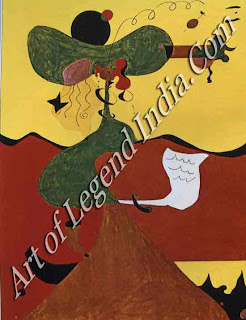
In
1929, Miro made a series of four 'Imaginary Portraits' based on paintings of
the past; this one was inspired by an engraving of a portrait by the minor
English painter George Engleheart (1752-1829). The head and neck of the sitter
are reduced to little more than cipher underneath the dominating form other
broad-brimmed hat.
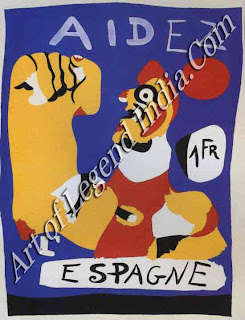 Miro
felt despair at the Spanish Civil War and he produced this silk-screen print to
be sold in aid of relief for his native country the price of one franc is a
bold part of the design. The powerfully conceived figure is shown clenching a
massive fist in the Loyalist salute and the inscription tells of the 'immense
creative resources' of the people of Spain.
Miro
felt despair at the Spanish Civil War and he produced this silk-screen print to
be sold in aid of relief for his native country the price of one franc is a
bold part of the design. The powerfully conceived figure is shown clenching a
massive fist in the Loyalist salute and the inscription tells of the 'immense
creative resources' of the people of Spain.
On
his return to Paris from America, Miro produced a great number of paintings in
two complementary styles which have been described as 'slow paintings' and
'quick paintings'. This light-hearted work belongs to the former category, with
its careful delineation of shapes and forms and its dense application of bright
primary colour.
 Miro
was haunted by the theme of the night, the time for dreams, silence and
solitude and for mystic communion with the stars. His nocturnal landscapes are
often inhabited by women, who sway in the moonlight, and 'birds of the night'
symbols of the flight of the spirit from the waking consciousness of day.
Miro
was haunted by the theme of the night, the time for dreams, silence and
solitude and for mystic communion with the stars. His nocturnal landscapes are
often inhabited by women, who sway in the moonlight, and 'birds of the night'
symbols of the flight of the spirit from the waking consciousness of day.
Miro's
decorative style was well adapted to work on a large scale and he liked the
challenge of painting for a specific public place. This mural almost 20 feet
wide was painted for the dining room of the Harkness Commons building at
Harvard University, at the suggestion of the great architect Walter Gropius.
Miro executed the painting in Barcelona and it was installed in 1951, but in
the next few years it was found that it was deteriorating and Miro proposed
that a ceramic version should be substituted. Miro described the subject cryptically
as 'of a moralistic and poetic significance', but some commentators have
suggested that it shows a bullfight scene. In the centre of the composition is
a bull, with two enormous black horns and the enlarged sexual organs so often
seen in Miro`s work.
This
is the last in a series of three similar paintings (Blue I, II and III) flint
Mira executed in 1961. It illustrates the great range of Miro's imagination,
for whereas many of his best-known works are comparatively small and crowded
with restlessly moving incident and detail, this one is huge and serenely
sparse. It has links with some of his more characteristic works, however, in
the strange, amoeba-like form that trails across the blue void, suggesting the
immensity and mysteries of the universe. The blue itself-one of Miro's
favourite colours was described by his early champion, Rene Gaffe, as 'a savage
blue, insolent, electric, which sufficed by itself to make the canvas vibrate'.
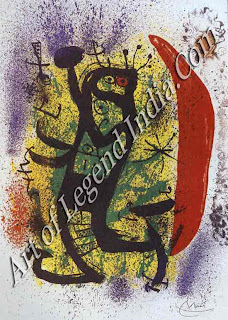
Miro
was one of the greatest graphic artists the 20th century has seen, excelling
particularly at lithography the making of prints from a specially prepared
stone surface. This is one of a series of ten prints by Miro and nine other
artists published as a portfolio to benefit the Swiss Centre for Clinical
Research on Cancer.
This
is one of a series of six lithographs entitled 'Seers'. A seer is a prophet or
someone who has the power to see into the future, and the handprints here
allude to the idea of palm-reading. The bright colours, spattered background
and whirling shapes suggest the state of ecstasy which the seer must enter in
order to transcend earthly experience.
Writer
– Marshall Cavendish
 This
is one of the first paintings in which Mini worked in the style to which a
friend gave the name 'detallista', characterized by great attention to detail
and sharpness of focus from foreground to background. The overall feeling,
however, is not naturalistic, for the stylized forms and the rhythmic patterns
made by, for example, the lines of cultivation and the branches against the
sky, produce an effect somewhat like a complex stage set. Miro holds together
the diverse elements with consummate skill, and the bright colours and clear
forms convey with great vividness the heat of his native Catalonia.
This
is one of the first paintings in which Mini worked in the style to which a
friend gave the name 'detallista', characterized by great attention to detail
and sharpness of focus from foreground to background. The overall feeling,
however, is not naturalistic, for the stylized forms and the rhythmic patterns
made by, for example, the lines of cultivation and the branches against the
sky, produce an effect somewhat like a complex stage set. Miro holds together
the diverse elements with consummate skill, and the bright colours and clear
forms convey with great vividness the heat of his native Catalonia.






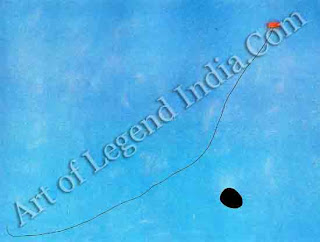

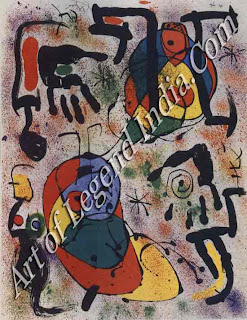










0 Response to "The Spainish Great Artist - Joan Miro Painting Gallery"
Post a Comment